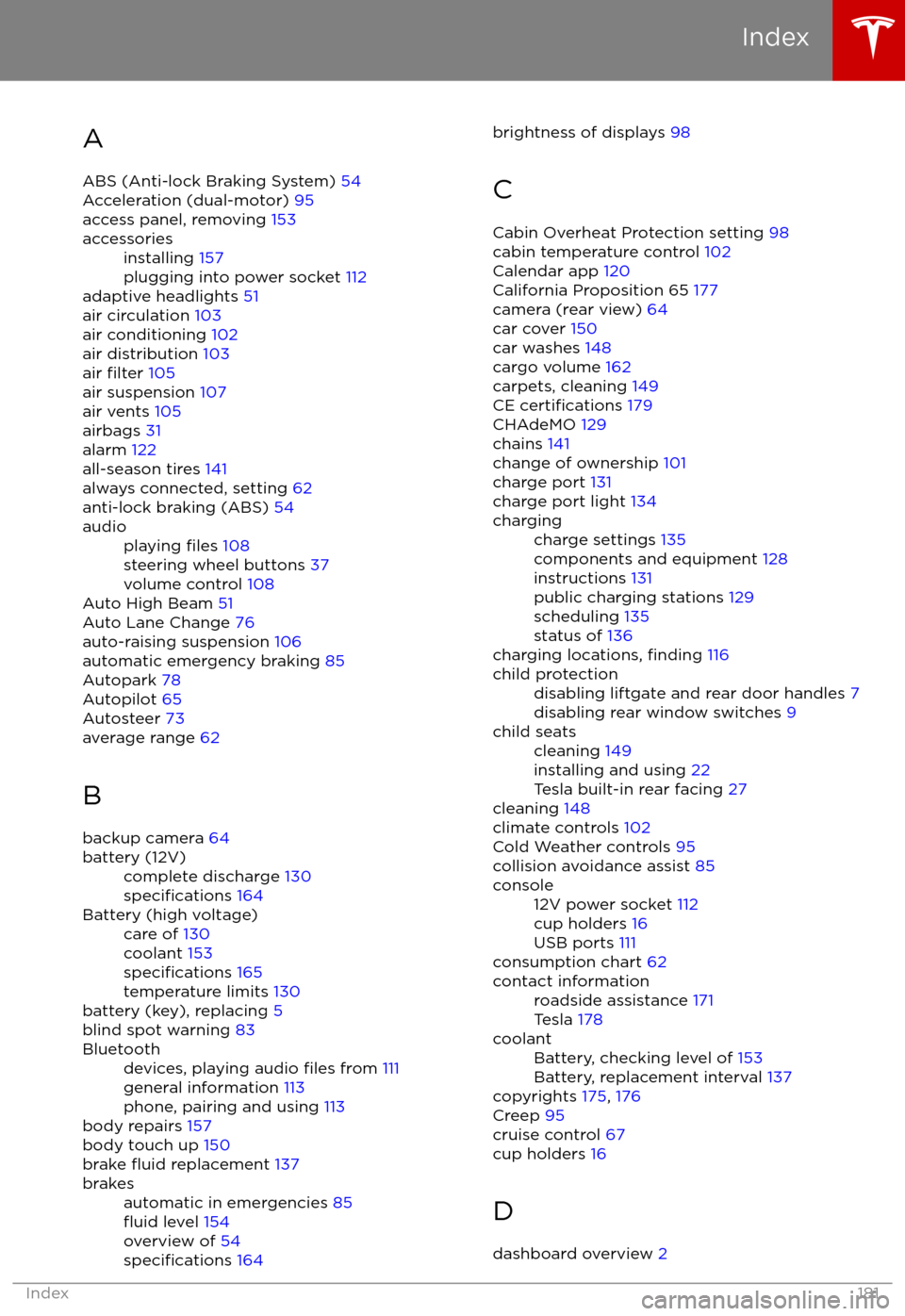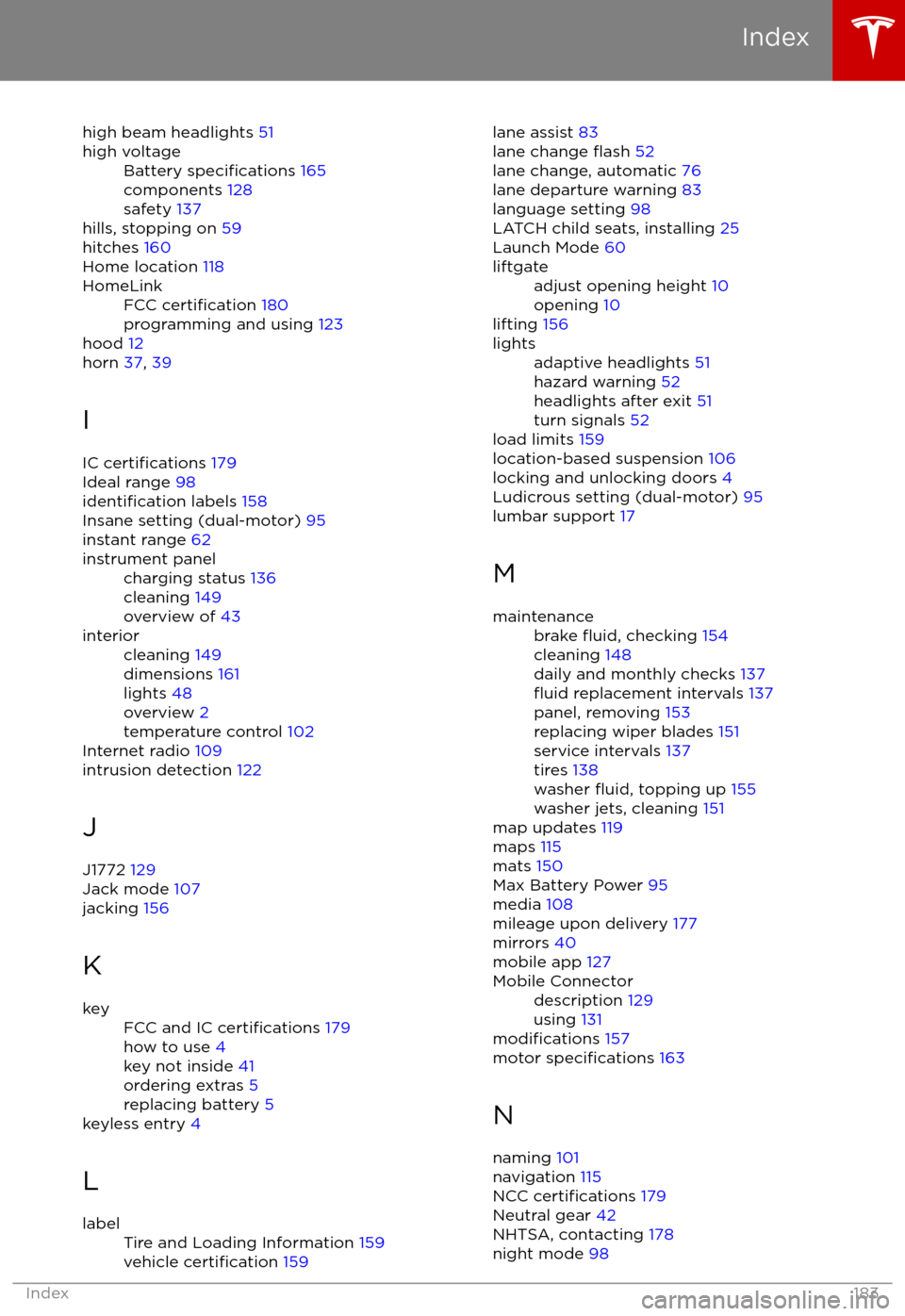2017 TESLA MODEL S battery
[x] Cancel search: batteryPage 154 of 188

Removing the Maintenance Panel
To check
fluid levels, remove the maintenance
panel:
1. Pull the rear edge of the maintenance panel upward to release the
five clips that
hold the panel in place.
2. Maneuver the maintenance panel toward the windshield to remove.
Caution: The maintenance panel protects
the front trunk from water. When re-
attaching, make sure it is fully seated.
Checking Battery Coolant
If the quantity of
fluid in the cooling system
drops below the recommended level, the
instrument panel displays a warning message.
Stop Model S as soon as safety permits and
contact Tesla.
Fluid Level Check
Tesla checks the Battery coolant level at the
regularly scheduled maintenance intervals. On a single motor Model S, you can check it
yourself. To do so, park Model S on level
ground. When Model S is cool, remove the
maintenance panel (see Removing the
Maintenance Panel on page 153).
Check the fluid level visually by looking at the
outside marks on the side of the reservoir. DO
NOT REMOVE THE FILLER CAP AND DO NOT
ADD FLUID. Doing so can result in damage
not covered by the warranty.
The
fluid level should be between the MIN and
the MAX marks. If you notice that the fluidlevel has dropped significantly, contact Tesla
before using Model S.
Topping Up the Battery Coolant
Under no circumstances should you add
coolant. If the instrument panel warns you that
the
fluid level is low, contact Tesla
immediately.
To maximize the performance and life of the Battery, the cooling system uses a
specifictype of G-48 ethylene-glycol coolant (HOAT).
Contact Tesla for more specific information
about the coolant.
Fluid Reservoirs
Maintenance153
Page 165 of 188

Brakes
Type
4-wheel anti-lock braking system (ABS)
with Electronic Brake Force Distribution,
Integrated Advanced Stability Control and
Electronic Accelerator pedal actuated
regenerative braking systemCalipersFour piston fixedRotor Diameters (ventilated)Front: 13.98”/355 mm
Rear: 14.37”/365 mmFront Rotor thicknessNew: 1.26”/32 mm
Service limit: 1.18”/30 mmRear Rotor thicknessNew: 1.10”/28 mm
Service limit: 1.02”/26 mmFront Brake Pad Thickness (excluding back plate)New: 0.354”/9.0 mm
Service limit: 0.078”/2 mmRear Brake Pad Thickness (excluding back plate)New: 0.315”/8.0 mm
Service limit: 0.078”/2 mmElectronic Parking Brake (EPB) Pad Thickness
(excluding back plate). Electronic calipers self-
adjust for pad wear.New: 0.216”/5.5 mm
Service limit: 0.039”/1 mmParking brakeElectrically actuated parking brake
calipers
Suspension
FrontIndependent, double wishbone, air spring
or coil spring/telescopic damper, sway barRearIndependent, multi-link, air spring or coil
spring/telescopic damper, sway bar (air
suspension vehicles only)
Battery - 12V
Rating33 amp-hr or higherVoltage and Polarity12V negative (-) ground
Subsystems
164Model S Owner
Page 166 of 188

Battery - High VoltageTypeLiquid-cooled lithium ion (Li-ion)Rating60, 70, 75, 85, 90, or 100 kWh (at
beginning of life)Nominal Voltage - 85, 90, and 100 kWh
Nominal Voltage - 60, 70, 75 kWh350 V DC
300 V DCTemperature RangeDo not expose Model S to ambient
temperatures above 140
Page 173 of 188

Use a Flatbed OnlyUse a
flatbed trailer only, unless otherwisespecified by Tesla. Do not transport Model S
with the tires directly on the ground.
Caution: Damage caused by transporting is not covered by the warranty.Caution: To transport Model S, follow theinstructions exactly as described next.
Disable Self-Leveling (air
suspension vehicles only)
If Model S is equipped with Smart AirSuspension, it automatically self-levels, even
when power is
off. To prevent damage, you
must activate Jack mode to disable self- leveling:
1. Touch Controls > Suspension on the touchscreen.
2. Press the brake pedal, then touch Very High to maximize height.
3. Touch Jack.
When Jack mode is active,
Model S displays this indicator
light on the instrument panel,
along with a message telling you
that active suspension is
disabled.
Note: Jack mode cancels when Model S is
driven over 4.5 mph (7 km/h).
Warning: Failure to activate Jack mode on
a Model S equipped with Smart Air Suspension can result in the vehicle
becoming loose during transport, which
may cause
significant damage.
Activate Tow Mode
Model S may automatically shift into Park
when it detects the driver leaving the vehicle,
even if it has previously been shifted into Neutral. To keep Model S in Neutral (which
disengages the parking brake), you must use
the touchscreen to activate Tow mode:
1. Shift into Park.
2. Press the brake pedal, then on the touchscreen, touch Controls > Settings >
Service & Reset > Tow Mode.When Tow mode is active, Model S
displays this indicator light on the
instrument panel, along with a
message telling you that Model S is
free-rolling.
Note: Tow mode cancels when Model S is
shifted into Park.
Caution: If the electrical system is not
working, and you therefore cannot
release the electric parking brake,
attempt to quick start the 12V battery. For
instructions, call Tesla. If a situation
occurs where you cannot disengage the
parking brake, use tire skids or transport Model S for the shortest possible distance
using wheeled dollies. Before doing so,
always check the dolly manufacturer
Page 178 of 188

Vehicle Telematics/Data Recorders
This vehicle is equipped with electronic
modules that monitor and record data from
various vehicle systems, including the motor,
Battery, braking and electrical systems. The
electronic modules record information about
various driving and vehicle conditions,
including braking, acceleration, trip and other
related information regarding your vehicle.
These modules also record information about
the vehicle
Page 182 of 188

AABS (Anti-lock Braking System) 54
Acceleration (dual-motor) 95
access panel, removing 153accessoriesinstalling 157
plugging into power socket 112
adaptive headlights 51
air circulation 103
air conditioning 102
air distribution 103
air
filter 105
air suspension 107
air vents 105
airbags 31
alarm 122
all-season tires 141
always connected, setting 62
anti-lock braking (ABS) 54
audioplaying files 108
steering wheel buttons 37
volume control 108
Auto High Beam 51
Auto Lane Change 76
auto-raising suspension 106
automatic emergency braking 85
Autopark 78
Autopilot 65
Autosteer 73
average range 62
B backup camera 64
battery (12V)complete discharge 130specifications 164Battery (high voltage)care of 130
coolant 153
specifications 165
temperature limits 130
battery (key), replacing 5
blind spot warning 83
Bluetoothdevices, playing audio files from 111
general information 113
phone, pairing and using 113
body repairs 157
body touch up 150
brake
fluid replacement 137
brakesautomatic in emergencies 85fluid level 154
overview of 54
specifications 164
brightness of displays 98
C Cabin Overheat Protection setting 98
cabin temperature control 102
Calendar app 120
California Proposition 65 177
camera (rear view) 64
car cover 150
car washes 148
cargo volume 162
carpets, cleaning 149
CE
certifications 179
CHAdeMO 129
chains 141
change of ownership 101
charge port 131
charge port light 134
chargingcharge settings 135
components and equipment 128
instructions 131
public charging stations 129
scheduling 135
status of 136
charging locations, finding 116
child protectiondisabling liftgate and rear door handles 7
disabling rear window switches 9child seatscleaning 149
installing and using 22
Tesla built-in rear facing 27
cleaning 148
climate controls 102
Cold Weather controls 95
collision avoidance assist 85
console12V power socket 112
cup holders 16
USB ports 111
consumption chart 62
contact informationroadside assistance 171
Tesla 178coolantBattery, checking level of 153
Battery, replacement interval 137
copyrights 175, 176
Creep 95
cruise control 67
cup holders 16
D
dashboard overview 2
Index
Index181
Page 184 of 188

high beam headlights 51high voltageBattery specifications 165
components 128
safety 137
hills, stopping on 59
hitches 160
Home location 118
HomeLinkFCC certification 180
programming and using 123
hood 12
horn 37, 39
I
IC
certifications 179
Ideal range 98
identification labels 158
Insane setting (dual-motor) 95
instant range 62
instrument panelcharging status 136
cleaning 149
overview of 43interiorcleaning 149
dimensions 161
lights 48
overview 2
temperature control 102
Internet radio 109
intrusion detection 122
J
J1772 129
Jack mode 107
jacking 156
K
keyFCC and IC certifications 179
how to use 4
key not inside 41
ordering extras 5
replacing battery 5
keyless entry 4
L
labelTire and Loading Information 159
vehicle certification 159lane assist 83
lane change flash 52
lane change, automatic 76
lane departure warning 83
language setting 98
LATCH child seats, installing 25
Launch Mode 60liftgateadjust opening height 10
opening 10
lifting 156
lightsadaptive headlights 51
hazard warning 52
headlights after exit 51
turn signals 52
load limits 159
location-based suspension 106
locking and unlocking doors 4
Ludicrous setting (dual-motor) 95
lumbar support 17
M
maintenancebrake fluid, checking 154
cleaning 148
daily and monthly checks 137
fluid replacement intervals 137
panel, removing 153
replacing wiper blades 151
service intervals 137
tires 138
washer
fluid, topping up 155
washer jets, cleaning 151
map updates 119
maps 115
mats 150
Max Battery Power 95
media 108
mileage upon delivery 177
mirrors 40
mobile app 127
Mobile Connectordescription 129
using 131
modifications 157
motor specifications 163
N naming 101
navigation 115
NCC
certifications 179
Neutral gear 42
NHTSA, contacting 178
night mode 98
Index
Index183
Page 186 of 188

steering wheel (continued)adjusting position 37
adjusting sensitivity 37
buttons 37
heated 37
scroll bars 37
steering, automatic 73
Streaming radio 109
summer tires 141
Summon 78
sunroof 15
suspension 107
suspension
specifications 164
T
telematics 177
temperatureBattery (high voltage), limits 130
cabin, controls for 102
heated steering wheel 39
outside 43
tires 169
tie-down straps
174
tilt detection 122
Tire and Loading Information label 159
tire noise 141
Tire Pressure Monitoring SystemFCC certification 180
overview of 142
tire pressures, checking 138
tire repair kitinflating with air only 146inflating with sealant 145
replacing the sealant canister 147tiresall-season 141
balancing 139
chains 141
industry glossary of terms 170
inspecting and maintaining 139
pressures, how to check 138
quality grading 169
replacing 140
replacing a tire sensor 142
rotation 139
specification 166
summer 141
temperature grades 169
tire markings 167
tire sealant 144
traction grade 169
treadwear grade 169
winter 141
toll system transponders, attaching 157
tolls, avoiding 117
torque
specifications 163
touch up body 150
touchscreenclean mode 149
cleaning 149
Controls 95
overview 90
Settings 98
software updates 126
Tow mode 172
towing 172
towing a trailer 160
towing eye, locating 173
towing instructions 172
TPMSFCC certification 180
overview of 142
traction control 56
trademarks 175, 176
Traffic-Aware Cruise Control 67Traffic-Based Routing 117
trailer hitches 160
transmission
specifications 163
transponders, attaching 157
Transport Canada, contacting 178
transporting 172
trip chart 62
trip meter 61
trip overview 117
trip planner 117
trunk, front 12
trunk, rearchild protection lock 7
disabling interior handle 7
TuneIn radio 109
turn signals 52
U
ultrasonic sensors 65
uniform tire quality grading 169
Units & Format 98
Unlock on Park 4
unlockingtrunk, front 12
trunk, rear 10
unlocking and locking doors 4
unlocking when key doesn